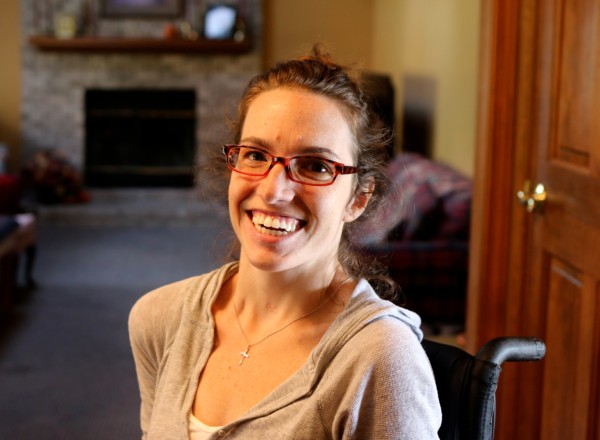
I went to meet with Ashley Harrington to learn about the services she has been receiving through Easterseals Crossroads. When I arrived at her home, her little white dog was barking and barking. I later learned his name was Rudy and we became fast friends.
Ashley’s dad invited me in and brought me to the kitchen where I was greeted by a girl with a great big smile named Ashley. Ashley’s mom and dad sat with us at the table and I could tell after just spending a few minutes with them that they were extremely supportive and warm people.
We all sat around the kitchen table and as Ashley finished her breakfast her dad told me a little bit about Ashley. He told me that Ashley had worked at a community pool over the summers throughout high school and was a competitive swimmer.
He told me that Ashley was a freshman in college at St. Mary’s at Notre Dame in South Bend, Indiana when she got sick. It was during a school break that Ashley took her very first trip on her own. She flew to Virginia with her boyfriend, at the time, to visit his brother who was attending the University of Virginia. Ashley started not feeling well on the trip and went to sleep at her boyfriend’s brother’s house. In the middle of the night, she woke up and told her boyfriend, “I can’t feel my arms or legs. I am numb all over.” Her boyfriend raced her to the emergency room in Virginia.
In the middle of the night, Ashley’s parents got a call from the emergency room. The nurse told them, “Your daughter is in a coma.” Her dad got out of bed immediately and started figuring out the fastest way to get to Charlottesville, VA. When he arrived at the hospital, Ashley was alert and groaning. Ashley got an MRI at the hospital and it showed that the damage was on both sides of the brain, which indicated that she had not had a stroke. The doctors immediately gave her steroids to reduce the swelling in her brain and began further testing.
The hospital finally determined that Ashley had Acute Disseminated Encephalomyelitis (ADEM). ADEM is a brief and intense attack of swelling in the brain and spinal cord. It is not clear what causes ADEM. It seems that many cases follow a viral or bacterial infection. ADEM is thought to be an autoimmune condition where the body’s immune system mistakenly identifies it’s own healthy cells and tissues as foreign and attacks them. The attack results in the inflammation. ADEM is typically a one-time occurrence and in Ashley’s case caused significant damage leaving her not able to speak or walk independently.
Ashley was in the hospital in Virginia for a month. Ashley’s brother was 16-years-old at the time and Ashley’s dad told me how helpful his neighbors, family, friends, and church were during the time they needed to be away from home and with Ashley.
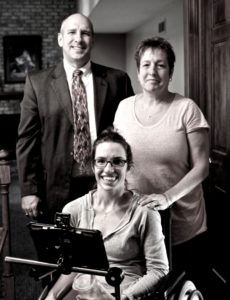 When Ashley came home from the hospital they had no treatment arranged and had no idea if she could understand them. Her dad said, “My only thought was how soon could Ashley get into therapy.” Ashley was dependent on a feeding tube to eat and her family had to use a Hoyer lift to get her in and out of bed and into the shower.
When Ashley came home from the hospital they had no treatment arranged and had no idea if she could understand them. Her dad said, “My only thought was how soon could Ashley get into therapy.” Ashley was dependent on a feeding tube to eat and her family had to use a Hoyer lift to get her in and out of bed and into the shower.
Her parents had researched where the best place for her rehabilitation would be and found the Rehabilitation Institute of Chicago (RIC). They learned that this had the best program for someone with ADEM and were very disappointed when they found out that the rehabilitation center was out of network with their insurance carrier.
Her dad worked for a long time to lobby with their insurance company to get approval for insurance to cover Ashley’s stay as in-network. Ashley’s dad told me, “I was walking into Starbucks when human resources called me to tell me it had finally been approved. I broke out in tears.”
Once it was approved, Ashley was taken to RIC and Ashley’s mom went with her. Ashley’s mom had been a 7th/8th grade teacher and did not return to work the next school year after Ashley got sick. Ashley’s mom lived in her room at RIC with Ashley the entire time she was there. She told me, “I just couldn’t leave her there. I needed to be there for her every day.” Ashley ended up spending 4 months at RIC. She kept getting one infection after the next and also suffered from multiple seizures.
Ashley just turned 29. She is now able to walk with someone helping her. She can even walk up the stairs to go to her bedroom. She now goes to Turnstone in Fort Wayne. Turnstone is an agency that provides therapy, education, wellness, and recreation programs to people with disabilities. While there Ashley does physical therapy such as walking on parallel bars, riding a bike, and weight training. She also does crafts. One of the highlights of being at Turnstone was the specialized bike Ashley has been able to ride. This is a tandem bike that allows her to ride with someone. She was thrilled to be on a real bike 9 years after she became ill. She was even able to do a bike race in an event called Fort 4 Fitness.
Once Ashley’s health was stable and she was making great strides physically, they researched ways to help Ashley communicate. To communicate with her parents she would raise her hand if she meant yes. During their research, they learned about augmentative communication and Easterseals Crossroads assistive technology program. They requested an assistive technology evaluation and Ashley was assigned to work with Craig Burns, Assistive Technology Specialist at Easterseals Crossroads.
Augmentative communication is a term that includes different forms of communication other than speech. These alternative forms of communication could be a picture board or a computer that has speech output.
Craig met with Ashley in her home to determine Ashley’s needs and 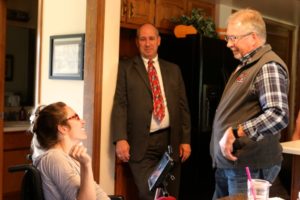 capabilities. Ashley’s dad told me, “We have never had such a thorough evaluation. During this process of learning about augmentative communication, we had met with an augmentative communication vendor, but Craig worked to determine Ashley’s strengths. He tried so many different things with her. He knew what to do and what to try. He is wonderful.”
capabilities. Ashley’s dad told me, “We have never had such a thorough evaluation. During this process of learning about augmentative communication, we had met with an augmentative communication vendor, but Craig worked to determine Ashley’s strengths. He tried so many different things with her. He knew what to do and what to try. He is wonderful.”
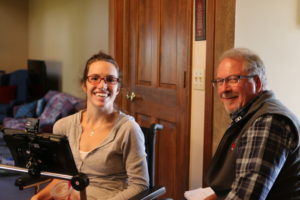 When Craig first met with Ashley he determined her primary need was communication, but realized that she also had access issues. When showing her communication devices it became clear that visually she tends to address what she can see on the right side more so than on the left. Craig recommended The Chat Fusion augmentative communication device and began to train her on the device. Craig said, “It would make you think that shifting icons towards the right side of a display would make all items visible to her, yet, this was not the case. She could still access “buttons” on the left side of the display, however, it required a more concerted effort.”
When Craig first met with Ashley he determined her primary need was communication, but realized that she also had access issues. When showing her communication devices it became clear that visually she tends to address what she can see on the right side more so than on the left. Craig recommended The Chat Fusion augmentative communication device and began to train her on the device. Craig said, “It would make you think that shifting icons towards the right side of a display would make all items visible to her, yet, this was not the case. She could still access “buttons” on the left side of the display, however, it required a more concerted effort.”
Craig further told me, “Her access to the screen vocabulary options was accomplished via two methods. She wanted to use a touch method, reaching out with her hand to touch the vocabulary items she desired. However, it was a difficult process and she was spending an enormous amount of energy concentrating on her pointer finger and focusing on the target she was seeking. Ashley tends to get close to the screen, without touching it, several times before she actually makes contact with the display. Because that method is such a physically stressful access tool, she was also given a head mouse control option on the Chat Fusion. Ashley has stable head control and this device will allow her to access the communication device with less energy requirement. As of yet, it is not her preferred method of access. Over time, with additional practice and settings adjustment, this method should allow her to be much more verbal by allowing quicker access to desired vocabulary. The Chat Fusion can be used on a desk or table and can also be mounted to her wheelchair.
Craig also worked with Ashley on her computer. A Headmouse Extreme device was attached to her laptop display at the top so she could use the exact same access method as she would with the Chat Fusion. With the headmouse she can access an on-screen keyboard, although, the target size is too small for her at this level of experience and she will need to practice using the headmouse control. A large print, large key keyboard was also provided with a keyguard. The keyguard allows her to rest her hand on the keyboard so she can focus her pointer finger on the desired character. She can push the character without hitting the wrong key. She does tend to push very lightly and comes off the key quickly when touch the keyboard or icons/buttons on the Chat Fusion display. Craig said, “She has a tremendous amount of work today, but seems to be motivated to succeed in achieve her goals. She is a very intelligent woman intent on reaching her goals, regardless of the obstacles.
Prior to my visit, Craig had sent Ashley some questions so I could get to know a little more about her. Ashley and her family had programmed the answers into her communication device.
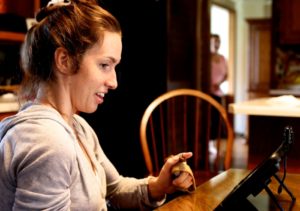
Talking with Ashley, I learned that the little white dog that had finally befriended me and was sitting at my feet was named Rudy. He was named after the movie Rudy. Rudy is about a kid with dyslexia that works really hard with a tutor to gain admission to Notre Dame and against all odds makes it on the Notre Dame football team.
Ashley with a big smile and such a positive attitude worked hard to use her 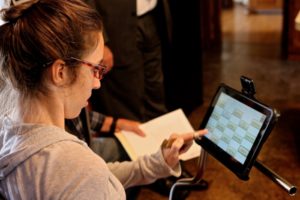 communication device to tell me about herself. She has limited motion, strength, and accuracy, but was persistent and was able to have a great conversation with me. When she would attempt to access her device, her parents would assist her in using her device and were very supportive saying, “You are right there, Ashley.”
communication device to tell me about herself. She has limited motion, strength, and accuracy, but was persistent and was able to have a great conversation with me. When she would attempt to access her device, her parents would assist her in using her device and were very supportive saying, “You are right there, Ashley.”
I enjoyed learning that Ashley’s goal is to return to college and she would like to become a physician’s assistant. She wants to get to a point where she can use a smart phone to text and read. I learned that she loves to visit Miami and her favorite movie is Father of the Bride. She also told me that she loves going to The Center for Courageous Kids camp each year in Southern Kentucky. This is a week long camp in the summer that the entire family gets to go to. This is a one-week overnight camp that is dedicated to kids with the same type of disability. This allows kids to be around other kids that are going through the same things they are and offers an opportunity for fun and to establish supportive relationship with peers.
The kids are paired with qualified volunteers and do many activities away from their parents to work on supervised independence away from their relatives. They get to have many life experiences such as swimming, fishing, and riding horses. The entire family looks forward to the camp each year. The camp is offered to children and their families at no charge to them. The Harrington’s indicate that the staff, facility, and food is great and they are very thankful that the camp is available to them.
Ashley shared with me what has been the hardest part about everything she has gone through. She told me, “It’s hard. Not only have I lost my clear voice, all other forms of communication are difficult. I have to be patient with people, and them with me.” I told Ashley that her words are a great reminder for everyone to be patient with others, because you never know what other people are going through. We wish Ashley all the best in everything she does in the future. I know with the support of her family, her determination, and assistive technology her voice will be heard and this will open up so many opportunities for her!

